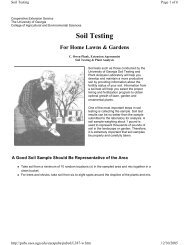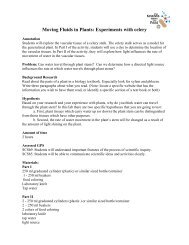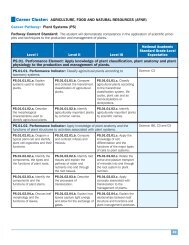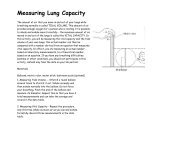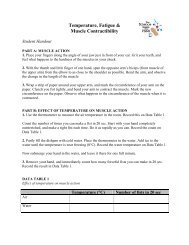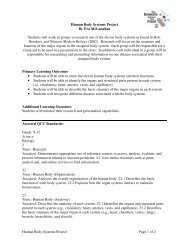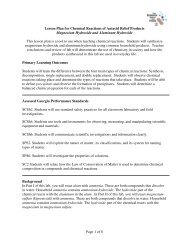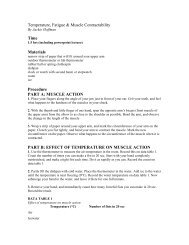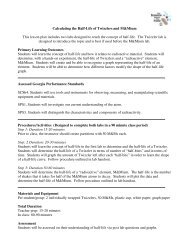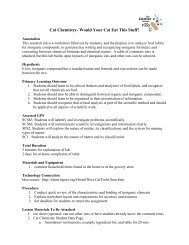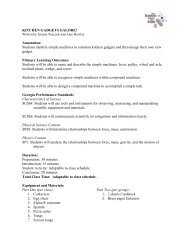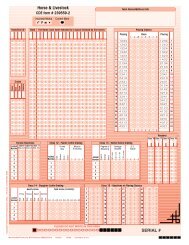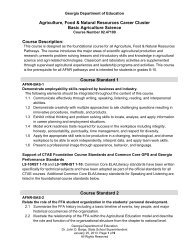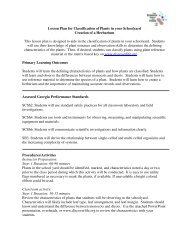ONE OF THESE THINGS IS NOT LIKE THE OTHER⦠Annotation In ...
ONE OF THESE THINGS IS NOT LIKE THE OTHER⦠Annotation In ...
ONE OF THESE THINGS IS NOT LIKE THE OTHER⦠Annotation In ...
Create successful ePaper yourself
Turn your PDF publications into a flip-book with our unique Google optimized e-Paper software.
<strong>ONE</strong> <strong>OF</strong> <strong><strong>THE</strong>SE</strong> <strong>THINGS</strong> <strong>IS</strong> <strong>NOT</strong> <strong>LIKE</strong> <strong>THE</strong> O<strong>THE</strong>R…<br />
Written by Amy Rowley and Jeremy Peacock<br />
<strong>Annotation</strong><br />
<strong>In</strong> this activity, students will explore the principles of sensory evaluation by participating in and<br />
analyzing the results of a cola triangle test. A triangle test is a difference test that is used to<br />
determine whether there is a sensory difference between two products.<br />
Primary Learning Outcomes:<br />
Students will be able to define the term triangle test and explain its use.<br />
Students will be able to calculate percentages based on a data set.<br />
Students will be able to explain the importance of sensory evaluation in food science.<br />
Assessed GPS:<br />
Not applicable.<br />
Duration:<br />
Preparation: 30 minutes<br />
<strong>In</strong>troduction: 15 minutes<br />
Student Activity: 20 minutes<br />
Conclusion: 15 minutes<br />
Total Class Time: 50 minutes<br />
Materials and Equipment:<br />
For Teacher Preparation:<br />
1. 5-oz. Plastic cups<br />
2. 1 2-L Bottle of Pepsi<br />
3. 2 2-L Bottles of Coke<br />
4. Drinking water<br />
5. Saltine crackers<br />
6. Napkins<br />
7. 12-oz. Can of Sprite (For Optional Extension)<br />
8. Blindfold (For Optional Extension)<br />
Per Student:<br />
1. One Of These Things is Not Like the Other student handout<br />
2. 5-oz. Cup of Sample A<br />
3. 5-oz. Cup of Sample B<br />
4. 5-oz. Cup of Sample C<br />
5. 5-oz. Cup of water<br />
6. 2 Saltine crackers<br />
7. Napkin<br />
A. Rowley & J. Peacock Page 1 of 5 10 January 2005
Safety:<br />
Because students will be allowed to drink during the activity, precautions should be taken to<br />
prevent materials from coming into contact with lab equipment or surfaces. Materials should<br />
remain in cups or on clean napkins at all times.<br />
Technology Connection:<br />
Not applicable<br />
Procedures:<br />
Teacher Preparation:<br />
Use the attached template to prepare a One Of These Things is Not Like the Other student<br />
handout for each student. For each student, label 4 cups “A,” “B,” “C,” and “water,”<br />
respectively. Label the 2-L bottle of Pepsi “A.” Label one 2-L bottle of Coke “B” and the<br />
second “C.” Fill each cup roughly half full with the appropriate sample.<br />
Estimated Time:<br />
30 minutes<br />
<strong>In</strong>troduction:<br />
Sensory evaluation, an important area of food science, is a tool used to analyze and interpret<br />
human sensory responses to food products based on the five senses: sight, sound, smell, taste,<br />
and touch. Sensory evaluation is used to improve existing food products or to determine<br />
consumer acceptability of new food products. Several types of sensory tests are used. A triangle<br />
test is a difference test that is used to determine whether there is a sensory difference between<br />
two products. For example, do consumers detect a difference between generic and name brand<br />
food items During a triangle test, panelists are presented with three samples and asked to<br />
identify the sample they believe to be different from the other two. Data is compiled from a<br />
number of panelists and analyzed to determine whether there is a detectable difference between<br />
the products. A detectable difference is often one in which fifty percent or more of panelists are<br />
able to correctly distinguish the odd sample from the other two. However, food companies and<br />
researchers may adjust these levels according to their particular interests or needs.<br />
Explain to students that they will be sampling three cola beverages: two are the same and one is<br />
different. Their task is to identify the odd cola sample.<br />
Estimated Time:<br />
15 minutes<br />
Activity:<br />
Provide each student with the materials listed above. Ask students to sample each of the three<br />
cola. Advise them to pay close attention to the color and flavor of each sample. Students should<br />
use the water and crackers to cleanse their palate between samples. Upon completion of<br />
sampling, students should circle, on the One Of These Things is Not Like the Other student<br />
handout, the letter of the sample that is different from the other two.<br />
A. Rowley & J. Peacock Page 2 of 5 10 January 2005
Estimated Time:<br />
20 minutes<br />
Optional Extension: Ask one or two students to step out of the classroom. As the class watches,<br />
pour, for each student sent out of the room, two cups of Coke and one cup of Sprite. Appoint a<br />
student to escort each student, one at a time, back into the classroom, blindfolded. Ask the<br />
student(s) to sample each of the three samples and identify the odd sample. <strong>In</strong> a blind sensory<br />
test, many individuals find it difficult to detect a difference between Coke and Sprite.<br />
Conclusion:<br />
Share with student the odd sample. As a class, compile the following data on the board: the<br />
number of students that were able to detect the odd sample, the number of male students that<br />
were able to detect the odd sample, and the number of female students that were able to detect<br />
the odd sample. Discuss with students any difficulties experienced in determining the odd<br />
sample. Have students individually answer the post-lab and discussion questions found on the<br />
One Of These Things is Not Like the Other student handout.<br />
Estimated Time:<br />
15 minutes<br />
Assessment:<br />
Assessment should be based on completion of the One Of These Things is Not Like the Other<br />
student handout.<br />
A. Rowley & J. Peacock Page 3 of 5 10 January 2005
Name:<br />
Date:<br />
Class Period:<br />
<strong>ONE</strong> <strong>OF</strong> <strong><strong>THE</strong>SE</strong> <strong>THINGS</strong> <strong>IS</strong> <strong>NOT</strong> <strong>LIKE</strong> <strong>THE</strong> O<strong>THE</strong>R<br />
Student Handout<br />
<strong>In</strong>troduction:<br />
Sensory evaluation, an important area of food science, is a tool used to analyze and interpret<br />
human sensory responses to food products based on the five senses: sight, sound, smell, taste,<br />
and touch. Sensory evaluation is used to improve existing food products or to determine<br />
consumer acceptability of new food products.<br />
A triangle test is a difference test that is used to determine whether there is a sensory difference<br />
between two products. For example, do consumers detect a difference between generic and<br />
name brand food items During a triangle test, panelists are presented with three samples and<br />
asked to identify the sample they believe to be different from the other two. Data is compiled<br />
from a number of panelists and analyzed to determine whether there is a detectable difference<br />
between the products. <strong>In</strong> this assignment, a detectable difference is assumed to be one in which<br />
fifty percent or more of panelists are able to correctly distinguish the odd sample from the other<br />
two.<br />
Purpose:<br />
To use triangle testing to determine the odd cola sample from a set of three cola samples.<br />
Materials:<br />
1. 3 Cola samples (A, B, and C)<br />
2. Cup of water<br />
3. Saltine crackers<br />
4. Napkin<br />
Cola Triangle Test:<br />
Sample each of the three cola beverages from left to right. Two samples are identical; one is<br />
different. Select the odd/different sample and indicate by placing an “X” next to the letter of the<br />
odd sample.<br />
<strong>In</strong>dicate<br />
Sample<br />
Odd Sample<br />
Comments<br />
A __________ _________________________<br />
B __________ _________________________<br />
A. Rowley & J. Peacock Page 4 of 5 10 January 2005
C __________ _________________________<br />
Post-Lab Questions:<br />
1. What percentage of students in the class was able to distinguish the odd sample<br />
2. What percentage of male students was able to distinguish the odd sample<br />
3. What percentage of female students was able to distinguish the odd sample<br />
4. Assume that in this sensory evaluation a detectable difference among samples is one in<br />
which thirty-five percent or more panelists are able to distinguish the odd sample from<br />
the other two. Based on the class data, is there a detectable difference among the<br />
samples<br />
Discussion Questions:<br />
1. What might account for the differences detected between the cola samples<br />
2. Why can some students detect differences between the samples while other students<br />
cannot<br />
3. During actual sensory evaluation, measures must be taken to reduce panelist bias towards<br />
food products. What measures could have been taken in this experiment to improve the<br />
reliability of the results.<br />
A. Rowley & J. Peacock Page 5 of 5 10 January 2005



